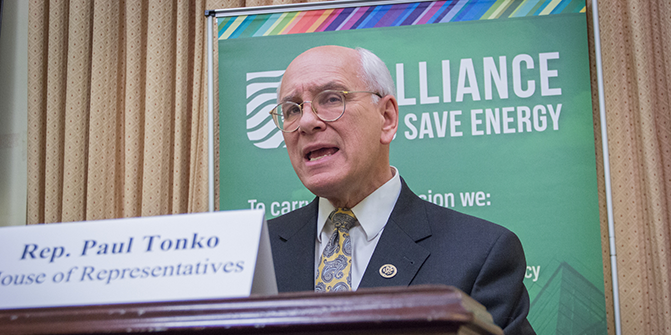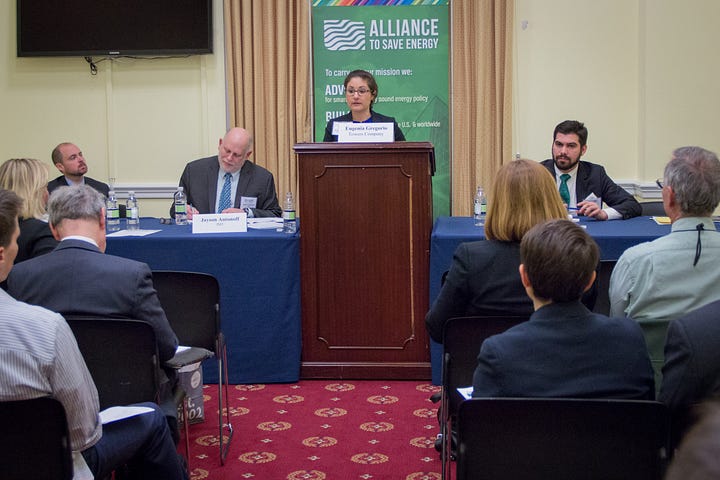Briefing Recap: What are the Roles of Benchmarking, Transparency and Codes in Energy-Efficient Buildings?
Let's Save Energy
Alliance to Save Energy's Blog

On Friday, February 26th, the Alliance to Save Energy hosted a briefing on Capitol Hill entitled “The Role of Benchmarking,Transparency and Codes in Driving a More Efficient Built Environment”. For those who missed the briefing or want a recap, please read on.
Representative Paul Tonko’s (D-N.Y.) keynote remarks opened Friday’s briefing with sweeping language on the value of energy efficiency, invoking America’s history of pioneerism and calling on all of us as a nation to lead the way in energy efficiency innovation. Rep. Tonko said, “Let’s green up, let’s smarten up and let’s build up our nation in a way that will mean more resources and more sustainability.” Rep. Tonko’s impactful remarks energized the crowd of congressional staff, private industry representatives and Alliance partners and previewed the two great panel discussions that followed.
Panel One -- Energy Benchmarking & Transparency: The New Frontier of Building Policy

Benchmarking is analogous to standardized testing -- but for buildings. It provides metrics that, taken periodically, can measure a building’s energy use over time; transparency refers to the process of sharing benchmarking data across a wide scale. The following are some salient points made by presenters during the first briefing panel:
- Jayson Antonoff, Technical Director of Building Energy Performance Policy at Institute for Market Transformation, opened his remarks by explaining that benchmarking allows building owners to make more informed decisions about investments in their buildings: “Tenants, potential buyers, financial institutions can have their potential unlocked when information is made transparent to the marketplace,” Antonoff explained.
- Marshall Duer-Balkind, Program Analyst in the Data & Benchmarking Division of the D.C. Department of Energy & Environment, agreed, drawing a simple comparison: “It’s just like looking at the miles per gallon of a car before buying it or reading nutrition labels at the grocery store. If you don’t measure it, you can’t manage it — and you just have no idea what’s going on.”
- Eugenia Gregorio, Director of Corporate Responsibility at the Tower Companies, emphasized the role of benchmarking in setting goals and making progress: “Why do we think energy benchmarking is important? Because we believe that supporting disclosure drives healthy competition — locally, nationally and on an international level.”
Panel Two -- From Paper to Steel: Codes and Compliance in the Built Environment

Building codes regulate everything about a building, from design, to construction, to alteration and maintenance. Building codes are meant to keep occupants safe and healthy and reduce the operational costs of a building. The following are a few of the salient points made by presenters during the second briefing panel:
- Maureen Guttman, Executive Director of the Building Codes Assistance Project, began moderation of the second panel with a question to the audience: “Let’s say we write very strong codes and get strong code adoption but they aren’t being used. What good are they?” As one might guess from the topic of the panel, Guttman answered by saying: “That is where code compliance comes in.”
- Furthering this point, David Cohan, Building Energy Codes Program Manager at the U.S. Department of Energy, explained that codes have the potential to save billions of dollars in operational costs. Cohan illustrated this by explaining that many states around the country use the same type of window, regardless of climate -- an energy-wasting scenario that could be easily remedied by the implementation of codes.
- Amy Schmidt, Advocacy Manager at the Dow Chemical Company, provided a business perspective, adding to and building upon the other presenters’ remarks by drawing a clear relationship between business success and efficiency. Schmidt said: “As a business, we know we need to do more with less in order to be successful. We use as much energy on a daily basis as the country of Australia — we have to set high sustainability goals for ourselves. For this reason, we as a company are very interested in codes.”
- Charles Gulledge, Vice President at ASHRAE, spoke to some of the challenges of code compliance, including a lack of knowledge concerning how to apply energy codes. Regardless, Gulledge emphasized, “Zero energy buildings are coming very soon. Standards and codes are going to take us there.”
STAY EMPOWERED
Help the Alliance advocate for policies to use energy more efficiently – supporting job creation, reduced emissions, and lower costs. Contact your member of Congress.
Energy efficiency is smart, nonpartisan, and practical. So are we. Our strength comes from an unparalleled group of Alliance Associates working collaboratively under the Alliance umbrella to pave the way for energy efficiency gains.
The power of efficiency is in your hands. Supporting the Alliance means supporting a vision for using energy more productively to achieve economic growth, a cleaner environment, and greater energy security, affordability, and reliability.



